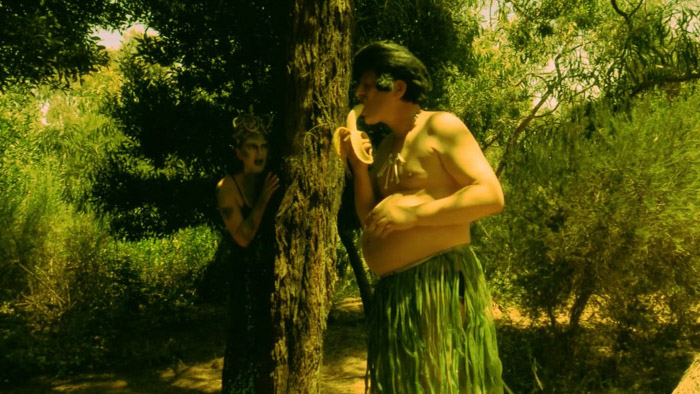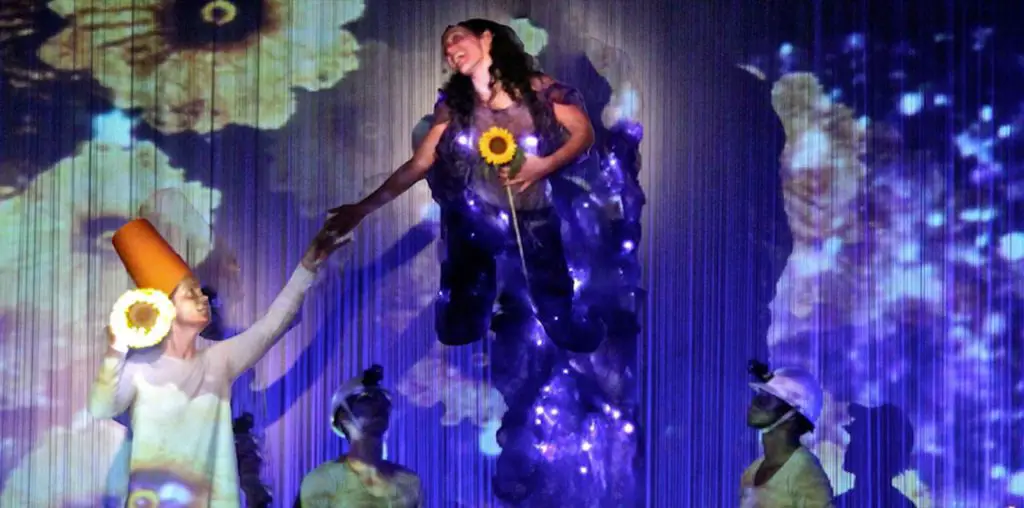
The Rotten Fruit of Eden tells the tale of Adam (David Black) wandering the grounds of the Garden of Eden as he is approached by the Snake of Eden (Hope Beale). As the snake attempts to coerce Adam into eating the forbidden fruit, she finds that the task far more difficult than anticipated. As Adam seems to find several legitimate reasons not to partake, the snake must find new ways to appeal to him.
Producer-writer-star David Black’s short falls somewhere between parody and satire, as it’s making fun of the story of Adam and Eve in the Garden of Eden. The filmmaker is clearly trying to make people laugh as he creates a somewhat modern retelling of the Biblical tale. As the two characters bicker back and forth about the worth of eating said forbidden fruit, the oddities of religion make their way to the forefront and attempt to choke the life out of the beliefs of many. This is not meant for easily offended viewers, but rather for those who can shrug off the finger-pointing and name-calling and can laugh at their shortcomings.
Black and his cohorts have a less-than-optimistic view of Christianity. Having attended a Catholic school from ages five to thirteen, I understand the narrative perspective of The Rotten Fruit of Eden. It’s essentially been hammered, quite vigorously, into my brain since I was just a tyke that these stories are legitimate. While I tend to err on the side of caution and think skeptically about just about everything, I’ve held firm to the idea that even if everything I’m being told didn’t actually happen, there is some truth to it. Seeing both sides of the coin is a quality essential to appreciating the film, as Black intentionally leads audiences down a very specific path intending for them to see the ridiculousness of the nearly 2000-year-old tale.

“…the snake attempts to coerce Adam into eating the forbidden fruit…”
While I appreciate the sentiment and laughed at the somewhat vexing jokes, its agenda proves most irritating. While I’m all for people to believe anything they choose, the almost aggressive nature by which Black attempts to shove his ideas down viewers’ throats is a bit too difficult to swallow. His almost belligerent approach is sure to turn off many viewers.
While the writing of The Rotten Fruit of Eden is too abrasive, the crew does a wonderful job creating idiosyncrasies that make the old story pop. Given that the seducer present in the Bible story is a serpent, it poses some issues for a low-budget film to create something believable in terms of a talking snake. Rather than an actual reptile, the being attempting to seduce Adam is a woman in a snake costume (think Medusa on a budget). The makeup is impressive, and the attention to detail is stellar. The choice to make her a snake person is brilliant as it lets an attractive woman portray the seductress attempting to tantalize the innocent man. This decision allows for a relatable and funny conversation that will resonate with viewers in one way or another.
Even as ridiculous as The Rotten Fruit of Eden is, viewers can see the talent present in Black, Beale, and the rest of the crew who played a role in creating this unique spectacle. It seems that the intention is to ruffle some feathers and force viewers to question their beliefs. While I certainly appreciate the sentiment behind Black’s mission, the fact is that he takes things a bit too far on occasion, forcing his creation to struggle on some levels.

"…viewers can see the talent present in Black, Beale, and the rest of the crew..."



The simple commandment is in Genesis 1:28: “Be fruitful and multiply.” Adam and Eve are supposed to be fruitful and multiply in the Garden of Eden by eating from the Tree of Life–the allegorical tree whose implied existence in Eden continues after the eviction from Eden in Genesis 3:24. But instead of procreating by eating from the Tree of Life while still in the Garden, they eat forbidden mystery fruit from a forbidden mystery tree named the Tree of Knowledge of Good and Evil, or, as many call it, the Tree of Knowledge.
But what forbidden fruit do they eat, and how does the eating of this fruit from the wrong tree prevent them from obeying the simple commandment to be fruitful and multiply by eating from the Tree of Life? Before this question can be answered, the location of the forbidden tree must first be determined. The evidence in the story tells us exactly where that location is within the Garden of Eden.
The Genesis story tells us in Genesis 2:9 and 3:3 both trees are in the center of the allegorical Garden. So the forbidden Tree of Knowledge of Good and Evil is right next to the allowed tree, the Tree of Life, and it’s fruit.
If the forbidden fruit from the forbidden tree is literal fruit, the eating of this fruit would give only knowledge of the fruit’s taste, not the knowledge of good and evil. But the covering of the genitals with fig leaf aprons following the eating of the “fruit” does indicate sudden acquisition of “knowledge of good and evil,” a knowledge that results in sexual shame.
It is difficult to understand how eating literal fruit results in sexual shame. And it is difficult to understand how normal and necessary sexual relations between Adam and Eve result in sexual shame since the only specific commandment to them is to “be fruitful and multiply” in the Garden, a commandment they disobey, because no children are produced until after the eviction from Eden, and after they have normal and necessary sexual relations for the first time in Genesis 4:1.
But their obedience is too late: guardian cherubim and a flaming sword prevent reentry into the Garden.
Adam and Eve execute double disobedience when they eat of the fruit forbidden–they fail to procreate by doing what they are forbidden to do. And they fail to procreate by not doing what they are commanded to do. Both failures occur simultaneously.
The fruit in the Garden of Eden is not forbidden sexual pleasure, but forbidden nonprocreative sexual pleasure–nonprocreative sexual pleasure derived from a specifically forbidden sex act: Adam and Eve experience pleasurable engagement in nonreproductive anal sex when they yield to the temptation represented in the allegory by the talking snake.
This fruit of pleasure is located in the center of the allegorical Garden of Eden–Eve’s body–right next to the allowed Tree of Life, and its equally allowed fruit of pleasure.
In partaking of the forbidden pleasure from the forbidden second tree instead of the allowed pleasure from the allowed first tree, Adam and Eve disobey God’s first and only commandment to them to be fruitful and multiply in the Garden.
As offensive as the exegesis may be, it remains superior to the most popular exegesis identifying the fruit as a forbidden apple.
But how did the fruit ever become identified as an apple in the first place?
The belief that the fruit is an apple has its genesis in the 4th century Vulgate translation, where Saint Jerome chose to use in Genesis 3 the Latin noun malum, meaning “apple,” instead of the adjective malus, meaning “bad,” to identify the fruit Eve ate.
This was later corrected.
But the apple identity stuck, became widespread in the 12th century, and remains the apex popular identity reaching us in the 21st century, still based on no evidence for the existence of a literal fruit.
But to end positive, the acceptance of the evidence-based exegesis of the identity of the fruit in the world’s oldest and greatest mystery story is at last making headway, as increasing numbers of people manage to rise above their emotions and feelings, and acknowledge–at least until a better exegesis appears–the evidence in the Bible story of the talking fruit snake.
This long-forgotten exegesis explains everything, and offers enlightenment for the untrue and oft-repeated, “Only God knows what fruit they ate.” Yes, a Deity would know what “fruit” they “ate,” but the evidence in the Genesis story reveals the Deity’s knowledge of the fruit’s identity to anyone who wishes to know, and has the courage to overcome their emotional resistance and uneasiness resulting from being exposed to this knowledge.
Would the exposure be eating once again from the forbidden tree? Would a Deity want us to remain ignorant of the Genesis story’s meaning? No to both questions, because our garden is not their Garden–we are no longer living in the Garden of Eden’s state of grace.
And secondly, the evidence in the story clearly tells us that Adam and Eve did not disobey the “Be fruitful and multiply” Genesis 1:28 commandment for the purpose of acquiring knowledge of good and evil.
Their acquisition of this knowledge was a byproduct of their disobedient behavior, which was to experience forbidden nonprocreative sexual pleasure by eating allegorical fruit from the allegorical wrong tree in the center of an allegorical garden, while at the same time quite possibly living in a literal garden with literal fruit trees and literal snakes that do not talk to women.